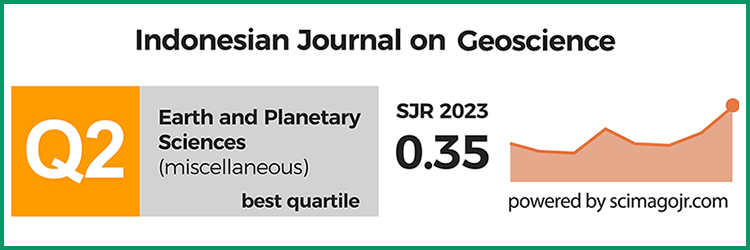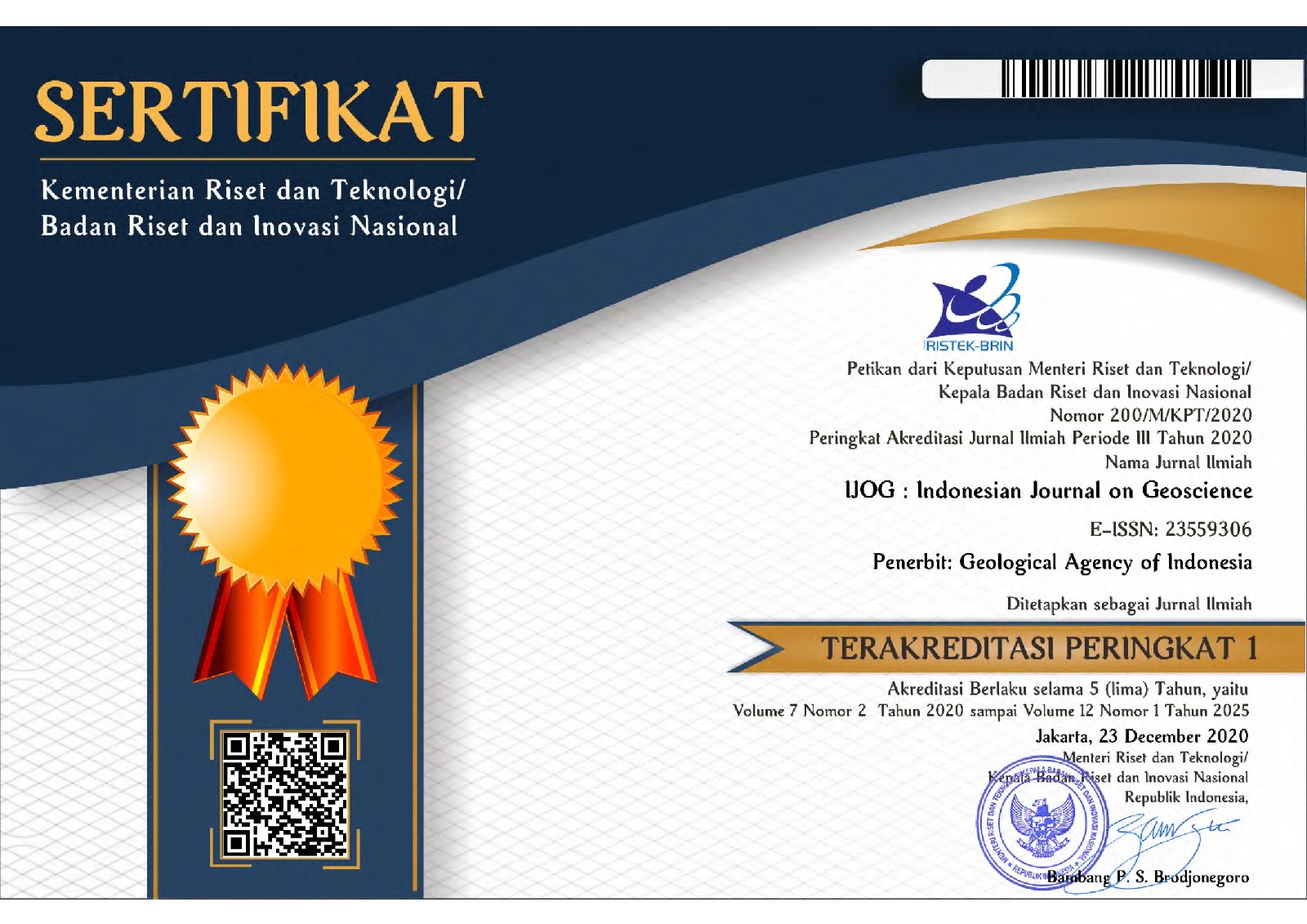Stratified Sampling to Define Levels of Petrographic Variation in Coal Beds: Examples from Indonesia and New Zealand
DOI:
https://doi.org/10.17014/ijog.3.1.29-51Keywords:
coal type, analysis of variance, stratified sampling, fine- and coarse-grained coalsAbstract
DOI: 10.17014/ijog.3.1.29-51
Stratified sampling of coal seams for petrographic analysis using block samples is a viable alternative to standard methods of channel sampling and particulate pellet mounts. Although petrographic analysis of particulate pellets is employed widely, it is both time consuming and does not allow variation within sampling units to be assessed - an important measure in any study whether it be for paleoenvironmental reconstruction or in obtaining estimates of industrial attributes. Also, samples taken as intact blocks provide additional information, such as texture and botanical affinity that cannot be gained using particulate pellets. Stratified sampling can be employed both on ‘fine’ and ‘coarse’ grained coal units. Fine-grained coals are defined as those coal intervals that do not contain vitrain bands greater than approximately 1 mm in thickness (as measured perpendicular to bedding). In fine-grained coal seams, a reasonable sized block sample (with a polished surface area of ~3 cm2) can be taken that encapsulates the macroscopic variability. However, for coarse-grained coals (vitrain bands >1 mm) a different system has to be employed in order to accurately account for the larger particles. Macroscopic point counting of vitrain bands can accurately account for those particles>1 mm within a coal interval. This point counting method is conducted using something as simple as string on a coal face with marked intervals greater than the largest particle expected to be encountered (although new technologies are being developed to capture this type of information digitally). Comparative analyses of particulate pellets and blocks on the same interval show less than 6% variation between the two sample types when blocks are recalculated to include macroscopic counts of vitrain. Therefore even in coarse-grained coals, stratified sampling can be used effectively and representatively.
References
Aitchison, J., 1989. Measures of location of compositional data sets. Mathematical Geology 21, p.787-790. DOI: 10.1007/BF00893322
Anggara, F., Sasaki, K., Rodrigues, S., and Sugai, Y., 2014. The effect of megascopic texture on swelling of a low rank coal in supercritical carbon dioxide. International Journal of Coal Geology, 125, p.45-56. DOI: 10.1016/j.coal.2014.02.004
ASTM, 1982. Standard definitions of terms relaing to Megascopic Description of Coal and Coal Seams and Microscopical Description and Analysis of Coal. ASTM Designation: D2796-82, p.357-360.
Beamish, B.B. and Crosdale, P.J., 1998. Instantaneous outbursts in underground coal mines: An overview and association with coal type. International Journal of Coal Geology, 35, p.27-55. DOI: 10.1016/S0166-5162(97)00036-0
Bustin, R.M., 1991. Quantifying macerals: some statistical and practical considerations. International Journal of Coal Geology 17, p.213-238. DOI: 10.1016/0166-5162(91)90033-F
Butland, C.I. and Moore, T.A., 2008. Secondary biogenic coal seam gas reservoirs in New Zealand: A preliminary assessment of gas contents. International Journal of Coal Geology, 76, p.151-165. DOI: 10.1016/j.coal.2008.05.017
Cameron, A.R., 1978. Megascopic description of coal with particular reference to seams in southern Illinois, In: Dutcher, R.R. (Ed.), Field Description of coal, ASTM STP 661. American Society for Testing Materials, p.9-32. DOI: 10.1520/STP35763S
Crosdale, P.J., 1995. Lithotype sequences in the Early Miocene Maryville Coal Measures, New Zealand. International Journal of Coal Geology, 28, p.37-50. DOI: 10.1016/0166-5162(95)00003-V
Davis, A., 1978. Compromise in coal seam description, In: Dutcher, R.R. (Ed.), Field Description of coal, ASTM STP 661. American Society for Testing Materials, p.33-40. DOI: 10.1520/STP35764S
Esterle, J.S., Kolatschek, Y., and O’Brien, G., 2002. Relationship between in situ coal stratigraphy and particle size and composition after breakage in bituminous coals. International Journal of Coal Geology, 49, p.195-214. DOI: 10.1016/S0166-5162(01)00077-5
Esterle, J.S., Moore, T.A., and Shearer, J.C., 1992. Comparison of macroscopic and microscopic size analyses of organic components in both coal and peat. 26th Newcastle Symposium: Advances in the study of the Sydney Basin, Newcastle, NSW, Australia, April 3-5, 1992, p.143-149.
Esterle, J.S., O’Brien, G., and Kojovic, T., 1994. Influence of coal texture and rank on breakage energy and resulting size distributions in Australian coals. Proceedings, 6th Australian Coal Science Conference, Newcastle, p.175-181.
Ferm, J.C., Moore, T.A., Lindsay, P., and Campbell, R.N., 2000. A guide to cored rocks and coal in the Waikato coalfields. CRL Energy Ltd., Lower Hutt. Report No. 00 - 41024, 72pp.
Friederich, M.C., Langford, R.P., and Moore, T.A., 1999. The geological setting of Indonesian coal deposits. Pacrim ‘99, Bali, Indonesia, p.625-631.
Friederich, M.C., Moore, T.A., Lim, M.S.W., and Langford, R.P., 1995. Constraints on coal formation in southeast Kalimantan, Indonesia. 6th New Zealand Coal Conference, CRANZ, Wellington, New Zealand, p.137-149.
George, A.M., 1982. Latrobe Valley brown coal-Lithotypes: Macerals: Coal properties. Australian Coal Geology, 4, p.111-130. DOI: 10.1016/0166-5162(95)00020-8
Hower, J.C. and Wild, G.D., 1994. Maceral/microlithotype analysis evaluation of coal grinding: examples from central Appalachian high volatile bituminous coals. Journal of Coal Quality, 13, p.35-40.
Hutton, A., Daulay, B., Herudiyanto, Nas, C., Pujobroto, A., and Sutarwan, H., 1994. Liptinite in Indonesian Tertiary coals. Energy and Fuels, 8, p.1465-1477. DOI: 10.1021/ef00048a037
ICCP, 1994. Vitrinite classification ICCP System 1994. International Committee for Coal and Organic Petrology, 24pp. DOI: 10.1016/S0016-2361(98)80024-0
ICCP, 1998. The new vitrinite classification (ICCP System 1994). Fuel, 77, 349-358. DOI: 10.1016/S0016-2361(98)80024-0
ICCP, 2001. The new inertinite classification (ICCP System 1994). Fuel, 80, 459-471. DOI: 10.1016/S0016-2361(00)00102-2
ISO, 2009. Methods for the petrographic analysis of coals - Part 3: Method of determining maceral group composition. ISO 7404-3. International Organization of Standardization, Geneva, Switzerland, 7pp.
Lamberson, M.N. and Bustin, R.M., 1993. Coalbed methane characteristics of Gates Formation coals, northeastern British Columbia: Effect of maceral composition. American Association of Petroleum Geologist Bulletin, 77, p.2062-2076.
Lewis, D.W., 1984. Practical Sedimentology. Hutchinson, Stroudsburg, PA., U.S.A.
Lyon, G.L. and Giggenback, W.F., 1994. The isotopic and chemical composition of natural gases from the South Island, New Zealand. 1994 New Zealand Petroleum Conference, Ministry of Commerce, p.361-369.
Mares, T.E. and Moore, T.A., 2008. The influence of macroscopic texture on biogenicallyderived coalbed methane, Huntly coalfield, New Zealand. International Journal of Coal Geology, 76, p.175-185. DOI: 0.1016/j.coal.2008.05.013
Moore, T.A., 1990. An alternative method for sampling and petrographically characterizing an Eocene coal bed, southeast Kalimantan, Indonesia. University of Kentucky, Lexington, 240pp.
Moore, T.A., 2012. Coalbed methane: A review. International Journal of Coal Geology, 101, p.36-81. DOI: 10.1016/j.coal.2012.05.011
Moore, T.A., Esterle, J.S., and Shearer, J.C., 2000. The rôle and development of texture in coal beds: Examples from Indonesia and New Zealand. In: Hadiyanto (Ed.), Southeast Asian Coal Geology Conference. Ministry of Mines and Energy, Bandung, p.239-252.
Moore, T.A. and Ferm, J.C., 1992. Composition and grain-size of an Eocene coal bed in southeastern Kalimantan, Indonesia. International Journal of Coal Geology, 21, p.1-30. DOI: 10.1016/0166-5162(92)90033-S
Moore, T.A., Ferm, J.C., and Orrell, S.A., 1989. Size-distribution of organic components in different megascopic coal types from an Eocene-age coal bed in Kalimantan, Indonesia, Coal Formation, Occurrence and Related Properties. Centre National de la Recherche Scientifique, Orléan, France, Paper No. 37.
Moore, T.A., Ferm, J.C., and Weisenfluh, G.A., 1992. Guide to Eocene coal types in Kalimantan Selatan, Indonesia, 2nd Edition, Department of Geological Sciences, University of Kentucky, Lexington, Kentucky, 74pp.
Moore, T.A., Flores, R.M., Stanton, R.W., and Stricker, G.D., 2002. The rôle of macroscopic texture in determining coalbed methane variability in the Anderson- Wyodak coal seam, Powder River Basin, Wyoming. In: Robison, C.R. (Ed.), 18th Annual Meeting of The Society for Organic Petrology. The Society for Organic Petrology, Houston, Texas, p.85-88.
Moore, T.A., and Orrell, S.A., 1991. A Hyper-Card stack for point counting the microscopic constituents of coal and peat. The Society for Organic Petrology Newsletter, 8, (2), p.10-12.
Moore, T.A., Shearer, J.C., and Esterle, J.S., 1993. Quantitative macroscopic textural analysis. The Society of Organic Petrology Newsletter, 9, p.13-16.
Moore, T.A., Shearer, J.C., and Miller, S.L., 1996. Fungal origin of oxidised plant material in the Palangkaraya peat deposit, Kalimantan Tengah, Indonesia: Implications for “inertinite” formation in coal. International Journal of Coal Geology, 30, p.1-23. DOI: 10.1016/0166-5162(95)00040-2
Moore, T.A. and Swanson, K.M., 1993. Application of etching and SEM in the identification of fossil plant tissues in coal. Organic Geochemistry, 20, p.769-777. DOI: 10.1016/0146-6380(93)90061-F
Newman, N.A., Moore, T.A., and Esterle, J.S.,1997. Geochemistry and petrography of the Taupiri and Kupakupa coal beds (Eocene), North Island, New Zealand. International Journal of Coal Geology, 33, p.103-133. DOI:10.1016/S0166-5162(96)00021-3
Pontollilo, J. and Stanton, R.W., 1994. Coal petrographic laboratory procedures and safety manual II. U.S. Geological Survey, Open-file Report 94-631, 69pp.
Ruppert, L.F. and Moore, T.A., 1993. Differentiation of volcanic ash-fall and waterborne detrital layers in the Senakin coal bed (Eocene), Tanjung Formation, Indonesia. Organic Geochemistry, 20, p.233-247. DOI:10.1016/0146-6380(93)90041-9
Schopf, J.M., 1960. Field description and sampling of coal beds. U.S. Geological Survey Bulletin, 1111-B, p.25-67.
Shearer, J.C., 1992. Sedimentology, coal chemistry and petrography of the Morley and Beaumont coal measures, Ohai coalfield, New Zealand. University of Canterbury, Christchurch, New Zealand, 325pp.
Shearer, J.C., 1995. Tectonic controls on styles of sediment accumulation in Late Cretaceous coal measures of the Ohai coalfield, New Zealand. Cretaceous Research, 16, p.367-384. DOI: 10.1006/cres.1995.1027
Shearer, J.C. and Moore, T.A., 1994a. Botanical control on banding character in two New Zealand coal beds. Palaeogeography, Palaeoclimatology and Palaeoecology, 110, p.11-28.
DOI: 10.1016/0031-0182(94)90107-4
Shearer, J.C. and Moore, T.A., 1994b. Grain-size and botanical analysis of two coal beds from the South Island of New Zealand. Review of Palaeobotany and Palynology, 80, p.85-114.
DOI: 10.1016/0034-6667(94)90095-7
Shearer, J.C. and Moore, T.A., 1999. Coal: Organic Petrology. In: Marshall, C.P. and Fairbridge, R.W. (Eds.), The Encyclopedia of Geochemistry. Kluwer Academic Publishers, Dordrecht, p.87-90.
Sherwood, A.M., Lindqvist, J.K., Newman, J., and Sykes, R., 1992. Cretaceous coals in New Zealand. In: McCabe, P.J. and Parrish, J.T. (Eds.), Controls on the distribution and quality of Cretaceous Coals. Geological Society of America, Special Paper, 267, Boulder, Colorado, p.325-346. DOI: 10.1130/SPE267-p325
G.W. and Cochran, W.G., 1989. Statistical methods. The Iowa State Press, Ames, Iowa. DOI: 10.3102/10769986019003304
Stanton, R.W. and Moore, T.A., 1991. The necessity for etching. The Society for Organic Petrology Newsletter, Laboratory Notes 8, (1), p.8-11.
Stopes, M.C., 1919. On the four visible ingredients in banded bituminous coal. Proceedings of the Royal Society, Series B 90, p.470-487. DOI: 10.1098/rspb.1919.0006
Stopes, M.C., 1935. On the petrology of banded bituminous coals. Fuel, 14, p.4-13.
Sykes, R., 1985. Paleoenvironmental and tectonic controls on coal measure characteristics, Ohai coalfield, Southland. Department of Geological Sciences. University of Canterbury, Christchurch, New Zealand.
Sykes, R., 1988. The Morley coal measures, Ohai coalfield, Southland. Coal type and depositional environment. New Zealand Departement Science and Industry Research, Report No. 170, 85pp.
Warnes, M.D., 1990. The palynology of the Morley Coal Measures, Ohai Coalfield. Ministry of Commerce, Wellington.
Woronow, A. and Love, K.M., 1990. Quantifying and testing differences among means of compositional data suites. Mathematical Geology, 22, p.837-852. DOI: 10.1007/BF00890666
Yu, K., Barry, J.C., and Esterle, J.S., 1997. Analysis of coal banding texture and implications for megascopic image analysis. International Journal of Coal Geology, 33, p.1-18. DOI: 10.1016/S0166-5162(96)00022-5



















